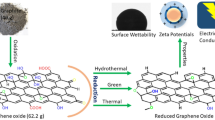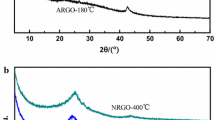Abstract
The main purpose of this study is to synthesize reduced graphene oxide (rGO) using graphite (GR) as a starting material. This paper explains didactic step-by-step of the synthesis, the role of each reagent, showing pictures of the entire process and including a well-explained characterization study. The rGO was prepared using modified Hummer’s method, followed by thermal reduction. The materials were characterized from the starting material (GR), through the intermediate material (GO) and finally the material of interest (rGO). Various techniques and procedures were used to characterize the materials such as X-ray diffraction, infrared and Raman spectroscopy, scanning electron microscopy, electrochemical characterization and dispersion analysis. Morphological and structural characterization of the obtained materials suggests that the synthesis and reduction to obtain rGO were effective. The obtained materials were electrochemically evaluated using ferri/ferrocyanide redox probe. The association of chemical oxidation of GR with KMnO4 in the presence of H2SO4 with further thermal reduction makes possible to produce rGO in large scale and with quality as noticed by outstanding electrochemical behavior toward the redox couple [Fe(CN)6]3−/[Fe(CN)6]4− probe.









Similar content being viewed by others
References
Singh V, Joung D, Zhai L, Das S, Khondaker SI, Seal S (2011) Progress in materials science graphene based materials: past, present and future. Prog Mater Sci 56(8):1178–1271
Lavender L (2014) Graphene: applications and future uses. The Institute of Physics, London
Geim AK, Novoselov KS (2007) The rise of graphene. Nat Mater 6(3):183–191
Bianco A et al (2013) All in the graphene family—a recommended nomenclature for two dimensional carbon materials. Carbon 65:1–6
Allen MJ, Tung VC, Kaner RB (2010) Honeycomb carbon: a review of graphene. Chem Rev 110:132–145
Zarbin AJG, Oliveira MM (2013) Carbon nanostructures (nanotubes and graphene): Quo Vadis? Quim Nova 36(10):1533–1539
Sengupta R et al (2011) A review on the mechanical and electrical properties of graphite and modified graphite reinforced polymer composites. Prog Polym Sci 36(5):638–670
Novoselov KS, Geim AK, Morozov SV, Jiang D, Zhang Y, Dubonos SV, Grigorieva AA (2004) Electric field effect in atomically thin carbon films. Science 306(1):666–669
Pei S, Cheng HM (2012) The reduction of graphene oxide. Carbon 50(9):3210–3228
Gao W (2015) Graphene oxide: reduction recipes, spectroscopy and applications. Springer, Cham
Wang Y, Li Y, Tang L, Lu J, Li J (2009) Application of graphene-modified electrode for selective detection of dopamine. Electrochem Commun 11:889
Sun JY, Huang KJ, Wei SY, Wu ZW, Ren F (2011) A graphene-based electrochemical sensor for sensitive determination of caffeine. Colloids Surf B 84:421
Hummers J, Offeman RE (1958) Preparation of graphitic oxide. J Am Chem Soc 80:1339–1340
Bagri A et al (2010) Structural evolution during the reduction of chemically derived graphene oxide. Nat Chem 2(7):581–587
Abdolhosseinzadeh S, Asgharzadeh H, Kim HS (2015) Fast and fully-scalable synthesis of reduced graphene oxide. Sci Rep 5:1–15
Kong L, Jiang X, Zeng Y, Zhou T, Shi G (2013) Molecularly imprinted sensor based on electropolmerized poly(o-phenylenediamine). membranes at reduced graphene oxide modified electrode for imidacloprid determination. Sens Actuat B Chem 185:424–431
Pumera M, Ambrosi A, Bonanni A, Khim EL, Poh HL (2010) Graphene for electrochemical sensing and biosensing. Trends Anal Chem 29(9):954–965
Dreyer DR, Park S, Bielawski CW, Ruoff RS (2010) The chemistry of graphene oxide. Chem Soc Rev 39:228–240
Dimiev AM, Tour J (2014) Mechanism of graphene oxide formation. ACS Nano 8:3060–3068
Stankovich S, Dikin DA, Piner RD, Kohlhaas KA, Kleinhammes A, Jia Y (2007) Synthesis of graphene-based nanosheets via chemical reduction of exfoliated graphite oxide. Carbon 45(7):1558–1565
Wu ZS, Ren W, Gao L, Liu B, Jiang C, Cheng HM (2008) Synthesis of high-quality graphene with a pre-determined number of layers. Carbon 47:493–499
Mcallister MJ, Li JL, Adamson DH, Schniepp HC, Abdala AA, Liu J (2007) Expansion of graphite. Chem Mater 19(4):4396–4404
Russel JB (1994) Química Geral, 2nd edn. Pearson, São Paulo
Clayden J, Greeves N, Warren S (2012) Organic chemistry, 2nd edn. Oxford University Press, Oxford
Nonomura Y, Morita Y, Deguchi S, Mukai S (2010) Anomalously stable dispersions of graphite in water/acetone mixtures. J Colloid Interface Sci 346:96–99
Khan M, Al-Marri AH, Khan M, Mohri N, Adil SF, Al-Warthan A, Siddiqui RMH, Alkhathlan HZ, Berger R, Tremelb W, Tahir MN (2014) Pulicaria glutinosa plant extract: a green and ecofriendly reducing agent for the preparation of highly reduced graphene oxide. RSC Adv 4:24119–24125
Shahriary L, Athawale AA (2014) Graphene oxide synthesized by using modified hummers approach. Int J Renew Energy Environ Eng 2:58–63
Bai YL et al (2015) Effects of graphene reduction degree on thermal oxidative stability of reduced graphene oxide/silicone rubber nanocomposites. High Perform Polym 27(8):997–1006
Ball DW (2006) Físico-Química, vol 2. Thomson, São Paulo
Ewing GW (2009) Métodos instrumentais de análise química, vol 2. Blücher, São Paulo
Nekahi PH, Haghshenas MD (2014) Transparent conductive thin film of ultra large reduced graphene oxide monolayers. Appl Surf Sci 295:59–65
Krishnamurthy G, Namitha RB (2013) Synthesis of structurally novel carbon micro/nanospheres by low temperature-hydrothermal process. J Chil Chem Soc 58(3):1930–1933
Stuart B (2004) Infrared spectroscopy: fundamentals and applications. Wiley, New York
Lerf A, He H, Forster M, Klinowski J (1998) Structure of graphite oxide revisited. J Phys Chem B 5647(97):4477–4482
Klinowski J, He H, Forster M, Lerf A (1998) A new structural model for graphite oxide. Chem Phys Lett 287:53–56
Yaragalla S, Meera AP, Kalarikkal N, Thomas S (2015) Chemistry associated with natural rubber—graphene nanocomposites and its effect on physical and structural properties. Ind Crops Prod 74:792–802
Han JH, Cho KW, Lee K-H, Kim H (1998) Porous graphite matrix for chemical heat pumps. Carbon 36(12):1801–1810
Bissessur R, Scully SF (2007) Intercalation of solid polymer electrolytes into graphite oxide. Solid States Ionics 178:877–882
Vinayan BP, Nagar R, Raman BN, Rajalakshmi KS, Dhathathreyan BS, Ramaprabhu A (2012) Synthesis of graphene-multiwalled carbon nanotubes hybrid nanostructure by strengthened electrostatic interaction and its lithium ion battery application. J Mater Chem 22:9949–9956
Zhang H, Zheng W, Yan Q, Yang Y, Wang J, Lu Z, Ji G, Yu Z (2010) Electrically conductive polyethylene terephthalate/graphene nanocomposites prepared by melt compounding. Polymer 51:1191–1196
Tang Z, Zhang L, Zeng C, Lin T, Guo B (2012) General route to graphene with liquidlike behavior by non-covalent modification. Soft Matter 8(35):9214–9220
Soldano C, Mahmood A, Dujardin E (2010) Production, properties and potential of graphene. Carbon 48(8):2127–2150
Feng H, Wang X, Wu D (2013) Fabrication of spirocyclic phosphazene epoxy-based nanocomposites with graphene via exfoliation of graphite platelets and thermal curing for enhancement of mechanical and conductive properties. Ind Eng Chem Res 52:10160–10171
Sharon M, Sharon M (2015) Graphene: An Introduction to the fundamentals and industrial applications. Scrivener Publishing, Beverly
Sreeprasad TS, Berry V (2013) How do the electrical properties of graphene change with its functionalization. Small 9(3):341–350
Acknowledgements
We thank FAPEMIG, CAPES, CNPQ and Rede Mineira de Química for the continuous support of our research that has led to this synthesis. We also thank Prof. Dr. Emerson S. Ribeiro for the partnership.
Author information
Authors and Affiliations
Corresponding author
Ethics declarations
Conflict of interest
No potential conflict of interest was reported by the authors.
Rights and permissions
About this article
Cite this article
Oliveira, A.E.F., Braga, G.B., Tarley, C.R.T. et al. Thermally reduced graphene oxide: synthesis, studies and characterization. J Mater Sci 53, 12005–12015 (2018). https://doi.org/10.1007/s10853-018-2473-3
Received:
Accepted:
Published:
Issue Date:
DOI: https://doi.org/10.1007/s10853-018-2473-3




